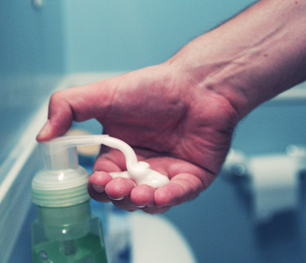Triclosan

Triclosan is commonly found in antibacterial hand soaps.
Triclosan (2,4,4’ –trichloro-2’-hydroxydiphenyl ether.*) is a pesticide widely used as an anti-microbial agent in consumer hygiene products and cosmetics, including hand soaps, toothpastes, deodorants and acne creams. It's also used as a material preservative, added to fabrics, plastics and other materials to impart antimicrobial properties. Tufts University reports that it is currently “used in hundreds of common commercial products.”
Triclosan has been detected in waste water, surface waters and soil in the United States. Human exposure is expected to occur occupationally in factories where the chemical is used or produced, and by the general population through products that contain the chemical.
Effects of Triclosan in Water
Triclosan is non-toxic to mammals with acute exposure, although reports indicate that it can cause skin irritation.
A recent study by the University of California, Davis, indicates that long term exposure to triclosan can impair the functioning of skeletal and heart muscles in rats. So far, long term studies have not shown evidence of carcinogenicity.
Triclosan is also of environmental concern. Although it is immobile in soil, it can bioaccumulate in exposed aquatic animals. For some aquatic species the chemical is toxic, and it can have endocrine disrupting effects on others. There is also concern that triclosan and other antibiotics in the environment will lead to the growth of drug-resistant bacteria.
Water Treatment for Triclosan
Research from the Korean Society of Environmental Engineers indicates that triclosan may be effectively treated with activated carbon.
*Also known as Irgasan, and the trade name Microban® when used in material treatment. Sources: EPA, TOXNET, UC Davis, Tufts University, UC Santa Barbara, Sacramento Bee, Photo: Flickr, user: Jeff Karpala
Site Index
Filtration Systems
- Aeration for Iron & Sulfide
- Backwashing Filters
(whole house & well units)
- Chlorine & Chemical Injectors
- Countertop Water Filters
- Garden Hose Filters
- Reverse Osmosis, Residential
- Reverse Osmosis, Commercial
- Shower Filters
- Specialty Filters
- Ultraviolet Systems
- Undersink Filters
- Water Softeners
- Whole House Filters
Cartridges
Parts
- Replacement Parts
- Faucets
- Filter Media
- Fittings
- Housings
- O-rings
- Pumps
- Pura UV
- R.O. Parts
- R.O. Tanks
- R.O. Booster Pump
- VIQUA UV